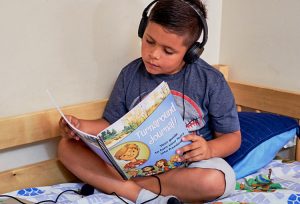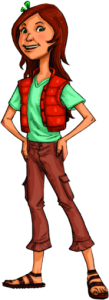
I am really careful with the courses and things that I promote, but recent developments (especially with COVID) are making even our young ones experience all kinds of negative feelings. As a parent myself, I feel the need to start doing something about it.
Anxiety disorders are on the rise and affect up to 20% of kids and bad parenting isn’t always the culprit. Anxious kids wear us out and break our hearts. We all wonder if this is our fault. It can feel like nothing is working.
Family members can develop a bitter mood as the child whines and complains. Anxious complaints can restrict a parent’s movement, demand a great deal of time, and can suck the life right out of the caregiver.
No parent chooses to be negative, it just happens as a consequence of the anxious disorder.
In other words, when a child suffers from anxiety, their day-to-day struggle impacts not just their own well-being, but their social relationships and the well-being of their family members, too.
Anxiety has its own set of rules. If you don’t know how it works you can inadvertently make anxiety worse even though you are genuinely trying to help.
How do you know if your child might be suffering from anxiety?
Warning signs for anxiety in children
Here are some of the emotional signs you might encounter:
- Frequent crying
- Child is experiencing constant state of fear and/or worry;
- Tantrums and meltdowns are happening more often than usual;
- Children are highly sensitive to changes in their environment and usually over react to them;
- They are worrying about making mistakes, no matter how tiny or insignificant;
- They exhibit compulsive behaviors (hand washing, finger tapping, etc.) and/or experience obsessive thoughts.
- Children have regular nightmares about death and dying;
- Your child becomes afraid or worried in various drop-off situations, such as school, daycare and friends’ and relatives’ homes;
- They are often pessimistic and have negative thoughts, like imagining the worst.
Also, here are some of the physical signs:
- They often complain of headaches, stomach aches or fatigue, seemingly without medical reason
- They are constantly tensed and experience a loss of appetite at daycare on in school
- They become distracted, restless, hyperactive and have troubles falling asleep or sleeping in general
- They will only use the bathroom at home
- They often shake or sweat without any noticeable reason
If you are interested in a more detailed assessment you can check out this checklist for child anxiety and when you finish you will get feedback that could help you decide if your child’s symptoms are within a normal range or suggestive of an anxiety problem requiring treatment.
Now, for adults there is an easy technique to help with anxiety that you can read about in this blog post that we published earlier on our site.
But for children and kids there was no easy help, for a long long time.
Well those days are now over and finally there is hope for our children too.
Families can also greatly benefit from working through the problem together, for the sake of all involved.
Is there a treatment that can help children with anxiety?
In the psychological field there will never be a treatment or program that is 100% effective in every situation. If you get a significant improvement from a specific treatment 60-70% of the time then you can be confident that it is extraordinarily effective.
That being said, cognitive-behavioral therapy (CBT) has impressive amounts of research supporting its effectiveness for treating anxiety.
The flagship program in this field specifically designed and created for children (recommended for ages 6-12) is called Turnaround anxiety program.

The program is designed as an audio adventure that takes place over an imaginary 10-day period.

Turnaround hired 14 child-actors and 6 adult actors to play the various parts. The premise of the Turnaround story is six anxious children go on a 10-day hiking trip with two therapists (Dr. Chris & Dr. David) and a teen mentor (Emily) who previously completed the trip. Emily acts as the guide who leads the kids into each day’s adventure in overcoming anxiety. The docs teach the kids different things to help them understand what anxiety is, how it affects them, and how to overcome it.
Each of the six children represent a different type of anxiety. Briana represents separation anxiety, Ashley has general fears (GAD), Matt struggles with OCD, Cedric with social anxiety, Madison is a perfectionist, and Jordan has panic attacks. (By the way, we don’t use any diagnostic terms or labels like “OCD” in the program.)
On their journey the six adventurers meet fun characters that your child will love. There’s Kerplop the talking beaver, Krank the hyperactive Samurai warrior who personifies anxiety, Chill the laid-back surfer dude who personifies positive coping behaviors, and Doliver the peculiar but ever-so-wise mountain man. There are also brief vignettes of other children and characters telling their stories of overcoming anxiety.
The program in this form was used as the treatment for anxious kids in graduate research at an Australian University. The results of the random controlled trials (RCT) were very strong regarding the effectiveness of Turnaround.

RCT trials are a specific type of scientific experiment and the gold standard for a clinical trial. Key to this is the random assignment of subjects to two or more alternative treatments. After assignment each group is followed in the same way. The only difference is in the type of treatment they receive. The random assignment minimizes any bias that might otherwise taint the results.
Here are some of those RCT results highlights:
- (a) reducing the clinical severity rating of the primary diagnosis; (b) decreasing the number of diagnoses held (see point 4 below); (c) improving overall level of functioning; (d) reducing child and parent reports of anxiety symptoms; and (e) reducing the experience of anxiety.
- For all measures, these improvements were either maintained or even improved upon at 3-month follow-up.
In other words, the changes stuck. - The percentage of children free from their primary diagnosis is comparable to that found in traditional face-to-face CBT (cognitive behavior therapy) for child anxiety.
Not everyone can get to therapy or find the right kind of therapists. Sometimes you can’t get a kid to go or participate. Plus, with Turnaround you don’t have to wait to get started and you can do a lot of work in a shorter period of time. - Children often have more than one anxiety diagnosis.
The results from this research suggest that Turnaround is not only able to reduce primary anxiety diagnoses, but comorbid disorders (occurring at the same time) as well, with 66.67% of the children being free from any diagnosis at 3-month follow-up.
The program is designed to deal with a variety of anxiety disorders

So, to summarize – does it work? Yes!
Of course some times there are exceptions as every child is specific, but you will see that this is a clinical, carefully designed treatment program that works as successfully as most other treatments.
It was designed by Dr. Christopher McCarthy, who is a Licensed Professional Counselor in practice for 20 years and Dr. David Russ, who specializes in treating severe anxiety. These people know what they are talking about.
Plus, if the program turns out to be ineffective, they will give you all your money back. You won’t get that option at your doctor’s office, that’s for sure!
To conclude I invite you to simply take a look at some of testimonials from happy parents and children. Just think about it, your own testimonial could be there published soon too!
In any case, I wish you find help that you are searching for, and that you are able to help your child work out all anxiety issues so that it becomes free and is able to fully enjoy life.
To your success as a parent!
Love,
S.
